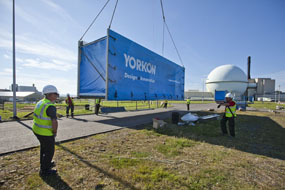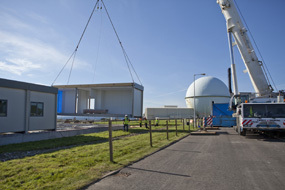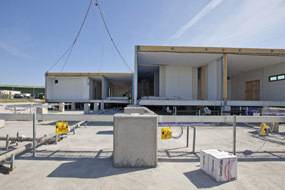01 September 2012
First Nuclear Analysis Laboratory to be Built Using Modular Construction at Dounreay
Britain's newest laboratory for the analysis of radioactive materials has just arrived on site at Dounreay in Scotland. The project, which is under construction by off-site specialist Yorkon, is also the first nuclear facility of its kind to be built using modular construction, and one of the most complex and remote modular building projects ever undertaken in the UK.
35 steel-framed modules have just been craned into position in only four days, significantly reducing disruption to operations at Dounreay. The units were pre-installed with partitions, fume cupboards, windows and office areas to minimise work on site.
The contract for the £9m building was awarded by site clean-up contractor, Dounreay Site Restoration Ltd (DSRL), to a team led by off-site specialist and main contractor, Yorkon.
The off-site approach is reducing the programme time for the building envelope by around 50 per cent. Construction of the 1,300sqm building is scheduled for completion in Spring 2013 when it will be handed over to the client to commence active commissioning. It is due to receive its first samples for testing in 2014, subject to regulatory approvals.
The scheme will provide six laboratories to allow DSRL to comply with its statutory and environmental monitoring requirements, and will remain in use for up to 25 years until the site decommissioning programme has been completed. The building will then be deconstructed - the steel modules are inherently easy to disassemble, recycle and re-use elsewhere, making the approach highly sustainable.
Commenting on the project, Iain Lyall, Project Manager at Dounreay Site Restoration Limited, said, "I am pleased to report the building installation phase went extremely well and was on schedule. It was meticulously planned, very professional throughout, and the whole site team worked really well together."
"The off-site solution enabled an almost overnight transformation of the site. This is a substantial building which was installed and ready for the final stages of fitting out in just four days. Speed of programme is important so we can have the building up and running as soon as possible, but it is also critical to get the quality right and to achieve best value. We are delighted with Yorkon's approach and performance to date, and look forward to the building's completion."
The Dounreay laboratory project will accommodate 36 fume cupboards, glove boxes and a specialised nuclear ventilation system with heavier, more complex ductwork compared to other applications of modular construction. It will also incorporate acid and non-acid fume extraction, HEPA filtration, and a discharge stack, and each laboratory will have one-hour fire containment to the entire building fabric - another Yorkon first for the modular industry.
Yorkon's partners in the Dounreay project are Studsvik for the nuclear ventilation design; JGC Engineering & Technical Services who are manufacturing and installing the nuclear ventilation system and M&E services, and S&B UK for the fume cupboards and laboratory equipment.
The building will have to withstand the rigours of a highly exposed marine environment, and it has been designed in full compliance with stringent nuclear industry requirements and regulations for ionising radiation. Its facilities include the laboratories, offices, drench showers and boot barrier in the active area, with ancillary accommodation for offices and locker rooms in the clean area.
Yorkon is part of the Portakabin Group.
www.yorkon.info
Editor's Notes
The Yorkon steel-framed off-site building system is a highly efficient and sustainable alternative to site-based construction for the nuclear industry. It offers:
- Programme times reduced by up to 50 per cent, allowing earlier completion and occupation
- Reduced disruption to nuclear site or decommissioning operations during construction
- Complete flexibility - buildings can be extended horizontally without decanting and because the internal walls are not load-bearing, the steel structure allows the layout to be completely reconfigured if required
- Simplified foundations and ground works
- Cost savings can be achieved through reduced time spent on construction activities on site
- A robust building system which can withstand the rigours of the most demanding external environments, such as wind loadings and exposed coastal locations
- Material wastage reduced by up to 90 per cent (source: WRAP)
- Up to 90 per cent fewer vehicle movements to site
- Improved quality and reduced future maintenance
- Ease of deconstruction for recycling when a building reaches the end of its life
- Enhanced thermal efficiency and air tightness for improved building performance
- Greater cost control and reduced risk of project delays.



